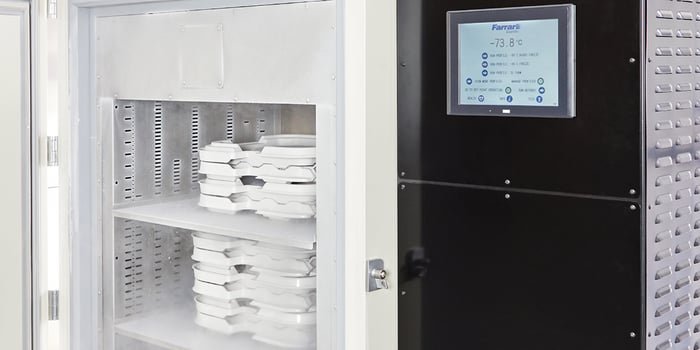Entegris is proud to announce a new relationship with Farrar Scientific, by Trane Technologies – a global climate innovator. Farrar offers best-in-class operating systems for ultra-cold temperature storage and controlled rate freeze/thaw chambers for pharmaceutical, biotech, and biorepository applications. Entegris offers the best-in-class Aramus™ bag for robust cold storage and transport. Collaborating with Farrar enables Entegris to offer a combined solution that accelerates the freeze/thaw process.
Powered by Trane Technologies, Farrar’s solutions fill an unmet need for large pharmaceutical and biopharmaceutical customers requiring flexible, modular, and efficient ultra-low temperature freeze/thaw processing, as well as -80°C (-112°F) bulk storage reach-ins and -70°C (-94°F) pallet chambers.
Farrar’s offerings and monitoring services, which include predictive analytics, provide an alternative to large-scale freezer farms or capital-intensive cold rooms used in the manufacturing of drugs, vaccines, and other biological products. Forced air convection cooling in Farrar’s controlled rate chamber greatly reduces +40˚ to -80˚C (+104° to -112°F) freeze/thaw times from days or weeks to hours, optimizing manufacturing efficiency and improving characteristics such as uniformity and repeatability versus competing technologies.
"This collaboration is a win-win for the industry,” said Holly Paeper, president, Trane Technologies Life Science Solutions. “Farrar and Entegris solutions jointly represent a step forward in reliability, simplicity, and affordability for end-to-end bioprocessing. We’re excited to discover how we can jointly advance precision temperature technology that helps protect quality and optimizes manufacturing.”
Entegris will showcase Farrar’s controlled rate chamber in our new Life Sciences Technology Center in Billerica, MA, which offers life sciences customers the opportunity to leverage our expertise in cold-chain challenges to reduce costs, increase speed to market, and optimize processes. This premier facility brings Entegris’ tools and technologies together in one place, where customers can test equipment for freeze/thaw processes to determine which products best fit their needs. As part of our solutions for manufacturing challenges, we now offer Aramus shaped 2D single-use bags with custom shapes, sizes, and assembly configurations for customers’ space and function requirements. They are resistant to extreme cold temperatures and withstand gamma sterilization, which makes them a preferred solution for freezing, transporting, storing, and thawing drug substances, like COVID-19 vaccines, cell therapies, and gene therapies.
As part of our solutions for manufacturing challenges, we now offer Aramus shaped 2D single-use bags with custom shapes, sizes, and assembly configurations for customers’ space and function requirements. They are resistant to extreme cold temperatures and withstand gamma sterilization, which makes them a preferred solution for freezing, transporting, storing, and thawing drug substances, like COVID-19 vaccines, cell therapies, and gene therapies.
“Our new technology center enables our customers to really understand the whole freezing process and optimize it before setting up a new lab of their own,” said John Lynch, vice president, Entegris. “Together with Farrar we are able to provide novel and high-value options for bulk drug freezing.”
We invite you to our Life Sciences Technology Center Open House during BioProcess International, September 27-30. Explore our cold chain equipment, talk to our freeze/thaw experts, and learn how we can help you identify the right solution to achieve your goals.




